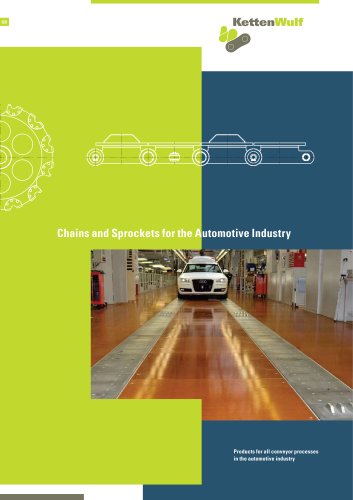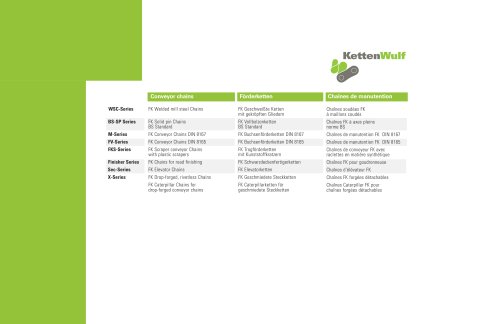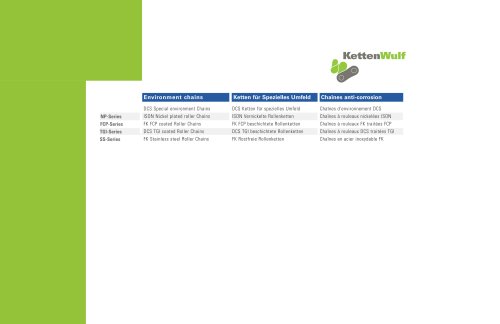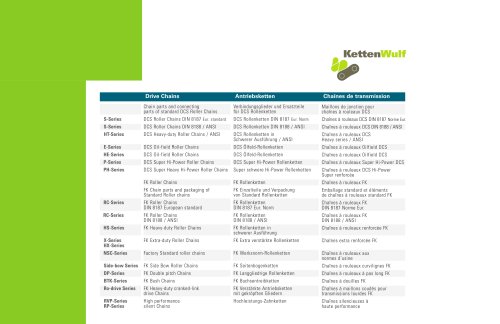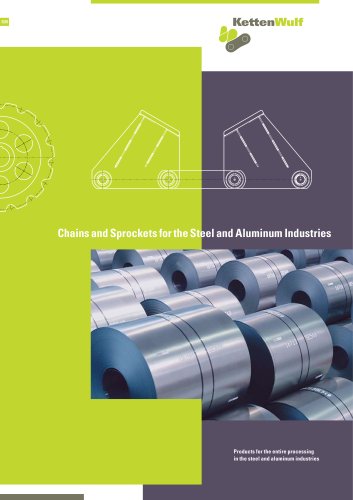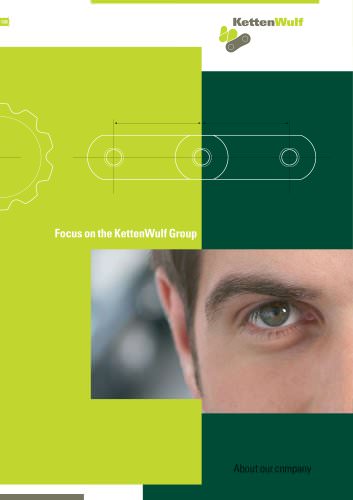 Website:
Ketten Wulf
Website:
Ketten Wulf
Catalog excerpts

Products for all conveyor processes in the automotive industry >
Open the catalog to page 1
tr.row {} td.cell {} div.block {} div.paragraph {}
Open the catalog to page 2
The headquarters of the KettenWulf Group in Kckelheim > Illustration top right: Production site in Sieperting, Germany Illustration center right: KettenWulf in Ferlach, Austria Illustration bottom right: The Chinese production and distribution site in Hangzhou >
Open the catalog to page 3
KettenWulf offers innovative conveyor chain technology for all applications in the automotive industry >
Open the catalog to page 4
Chains for cross transfer Chains for longitudinal transportation Chains for submerged body conveying Chains for slat conveyor >
Open the catalog to page 5
Cross transfer conveyor in the paint shop >
Open the catalog to page 6
Illustration 1: 1 2 Lube-free cross transfer chain, 160 mm pitch Illustration 2: Covered, lube-free cross transfer chain Illustration 3: 3 4 Lube-free cross transfer chain, 80 mm pitch Illustration 4: CC5-chain, 6 pitch Illustration 5: 5 6 Sprocket with patented noise dampening system Illustration 6: Lube-free roller chain for cross transfer conveyor in body shop >
Open the catalog to page 7
08|09 Car bodies travel through several rather different production steps in an automotive plant such as grinding, painting and drying. Usually the car bodies are moved lengthwise with skids or support frames. Depending on the client specifications, the appro-priate chains are equipped with devices which are specifically designed to catch the skids or support frames and move them along. Furthermore, it is possible to engineer other special requirements for your chain application: use special non-stick coatings on the chains,ۻ make the chains lubrication-free, implement accumulation top...
Open the catalog to page 8
Illustration 1: 1 2 Double-strand deep link chain Illustration 2: Chain with welded-on support plates (loose side) Illustration 3: 3 4 Spray booth chain with welded-on top plates Illustration 4: Chain with prism-shaped supports (fixed side) Illustration 5: 5 6 Spray booth chain with sealed bearing rollers to minimize surging Illustration 6: Sprocket with patented noise dampening system >
Open the catalog to page 9
Illustration 1: 1 2 Oven chain with inside mounted rollers for fixed side Illustration 2: Equivalent oven chain for loose side Illustration 3: 3 4 Oven chain with outside mounted rollers (fixed side) Illustration 4: Equivalent oven chain (loose side) Illustration 5: 5 6 Lube-free oven chain with mounted top plates Illustration 6: CC5-chain, pitch 6Г >
Open the catalog to page 10
Illustration 1: 1 2 Lube-free accumulation chain with high roller and guide-wheel strip combination Illustration 2: Lube-free accumulationchain Illustration 3: 3 4 Lube-free accumulation chain with two high rollers for skid carriage Illustration 4: CC5-B chain with high rollers >
Open the catalog to page 11
Submerging of a car body in a dip tank >
Open the catalog to page 12
Illustration 1: 1 2 Rotation tunnel with rotary axles and RoDip chains at each end Illustration 2: Car body during rotation Illustration 3: 3 4 RoDip chains: At the rotation supports the load is carried by ball-bearing support rollers Illustration 4: Low-maintenance chain hinge with the KettenWulf Sandwich-Sealing System Illustration 5: 5 6 Rotation support rollers Illustration 6: Return sprocket for RoDip-system >
Open the catalog to page 13
Illustration 1: 1 2 Pendulum conveyor chain in the Pre-Treatment system Illustration 2: Sprocket with exchan-geable tooth gaps Illustration 3: 3 4 Pendulum conveyor chain in the Catapho-retic Painting dip tank Illustration 4: Pendulum conveyor chain with rollers located at the middle of the chain pitch Illustration 5: 5 6 Pendulum conveyor chain with rollers located over the chain bushings Illustration 6: Lube-free pendulum conveyor chain >
Open the catalog to page 14
Illustration 1: 1 2 Sandwich-Sealing System with interior lip sealing Illustration 2: Re-lubrication system with the Sandwich-Sealing System Illustration 3: 3 4 Sandwich-Sealing System for lube-free chains Illustration 4: Lube-free chain with the Sandwich-Sealing System >
Open the catalog to page 15
Double-strand slat con-veyor in a finishing line >
Open the catalog to page 16
Illustration 1: 1 Sandwich-Sealing System for lube-free chain executions Illustration 2: 2 3 Chain hinge with the Sandwich- Sealing System in a conveyor with grinding dust exposure Illustration 3: Lube-free double-strand chain with outside mounted rollers Illustration 4: 4 5 Chain hinge with flanged rollers and the Sandwich-Sealing System after several years of grinding dust exposure Illustration 5: Lube-free double-strand chain with inside mounted rollers >
Open the catalog to page 17
Illustration 1: 1 2 Slat conveyor with 4m/12ft. wide slats in Finish Area Illustration 2: Two double-strand chains in combination with two single-strand chains Illustration 3: 3 4 Slat conveyor in the Finish Area and Fluid Filling, with staff stan-ding on the conveyor Illustration 4: Installation of double-strand chains in a new automotive plant Illustration 5: 5 6 Double-strand con-veyor in Final Product Inspection line Illustration 6: Double-strand conveyor chain with mounted wheel carrier plates >
Open the catalog to page 18
Illustration 1: 1 2 Automatic wheel assembly with double-strand chain; vehicles standing on their own wheels for the first time. Illustration 2: Double-strand chain with wide slats for twin wheels Illustration 3: 3 4 Finish Line with a shaft distance of 173m, con-veyor speed 0,8m/min Illustration 4: Double-strand chain with mounted carrier plates >
Open the catalog to page 19
Illustration 1: 1 2 Vehicles entering the Water Test Illustration 2: Slat conveyor chain with slats sliding on tracks Illustration 3: 3 4 Vehicles leaving the Water Test onto the Finish Line Illustration 4: Double-strand chain with outside mounted rollers and wheel carrier pieces Illustration 5: This slat conveyor chain in the Conservation area is operated in intervals with a speed of up to 40m/min. The sprockets are equipped with the patented KettenWulf noise dampening system. 5 6 Illustration 6: Double-strand chain with anti-skid surface >
Open the catalog to page 20
KettenWulf produces sprockets in various dimensions and designs according to customer requirements >
Open the catalog to page 21
Illustration 1: 1 2 Sprocket for RoDip-chain Illustration 2: Sprocket with exchan-geable tooth gaps Illustration 3: 3 4 Sprocket with patented noise dampening system Illustration 4: Sprocket with a three- segmented sprocket rim Illustration 5: 5 6 Split sprocket with one-sided hub Illustration 6: Sprocket for roller chain >
Open the catalog to page 22All Ketten Wulf catalogs and technical brochures
Archived catalogs
-
Technical information
15 Pages
-
Tools and lubricants
4 Pages
-
Conveyor chains
12 Pages
-
Wood and Lumber chains
22 Pages
-
Light conveying
32 Pages
-
Hollow pin Chains
9 Pages
-
Environment chains
11 Pages
-
Maintenance free
6 Pages
-
Drive chains
30 Pages
-
chains and sprockets
13 Pages

